This article will explore the key statistics and highlight Canada’s poverty and its relationship with crime. We aim to understand how poverty instigates most of the criminal activities in Canada and how their trends have varied in recent years.
It will also provide a thorough analysis of how poverty arouses crime and what particular circumstances prompt people to give in to criminal activities. Generally, global inflation and unemployment are the leading causes behind reduced household earnings, thereby resulting in a drastic increase in crime rates. A comparison of crime and poverty in different regions included later on in the article will solidify the case at hand.
The Causes of Crime in Canada and How they Relate to Poverty
Poverty is a multifaceted problem. In order to have a holistic view of its relation to crime, we will look at the factors that cause it, its effects, and its relationship with crime.
What are the Causes of Poverty
- CIWA is a group advocating for the rights of injured workers from many organizations. They aim to provide health and welfare services to these workers. One of their articles mentions that one of the main reasons for poverty in Canada is systematic inequality coupled with discrimination.
- Canada Without Poverty (CWP) reinforces this statement by saying that many of the poorer people in the county are refugees and immigrants who are discriminated against in terms of job opportunities, housing, government benefits, and even healthcare.
- CFTC, a children’s charity organization, mentions that being discriminated against on the basis of religion, social class, and political affiliations worsens the cycle of poverty.
- Additionally, the lack of social services aggravates the living conditions of poorer families. The absence of adequate welfare facilities, coupled with the economy today, makes survival quite difficult for such families.
What are the Effects of Poverty
- Dignity for All is a campaign headed by the Citizens for Public Justice. It aims to alleviate the challenges people face because of poverty. The most severe consequence of poverty has to be the rise of illnesses due to unsanitary conditions, the absence of a stable shelter, and poor nutrition. Canada has been warned by the United Nations about its poverty situation, given the country’s wealth and resources.
- The John Howard Society of Ontario states that some of the consequences of poverty include:
- Mental health issues, in turn, drastically increase the risk of suicide.
- Homelessness forces children to be put up for adoption/ sent to foster care.
- The inability to go to a good school or receive an adequate education. This later creates problems in seeking quality employment which continues the cycle of poverty.
- Food insecurity is another major consequence of poverty.
Dignity for All mentions that almost 1 in 8 people in Canada face a certain degree of food insecurity. Also, food banks are a temporary solution to the problem at hand.
How this Leads to Crime
Unemployment
As mentioned previously, one of the most dominating factors resulting in poverty is unemployment. This causes mental stress due to financial burdens and rising inflation. Thus, many people become victims of anxiety, depression, and even suicide.
Desperation
Additionally, the frustration that builds up with poverty, especially among those who have families to feed, causes people to try any means to have a stable income. This even includes drug dealing as it is quick and easy money and also helps escape poverty in most situations.
Unfair Means for Just Ends
Similarly, poverty brings about numerous shoplifting incidents, especially when people have to put food on the table.
In order to afford rent, people resort to illegal sources of income, fearing homelessness, the inability to receive education, and afford daily meals.
Prominent Statistics on Poverty in Canada
General Statistics
The national statistical office of Canada, Statistics Canada, provides some key figures on the poverty trends in the country.
- In 2020, the poverty rate in Canada stood at 8.1%, which is a decrease from 14.5% in 2015.
- In 2020, the highest poverty rate (31.3%) was observed among single-parent households where the parent is a woman and has a child between the age of 0 – 5 years. This figure is more than nearly fifty times the poverty rate of couple-parent families, which stands at 0.6%.
- The poverty rate among young adults saw a decrease from 20.9% to 14%. Young adults are identified within the range of 18 to 24 years.
- 3%, or a majority, of young adults (living alone or with roommates), were experiencing poverty. However, only 5.6% of young adults living with their families faced poverty in 2020.
Poverty Rates Across Provinces
The following graph from the Canadian Government lays out how the provinces differ in their poverty rates. It also shows how the rates changed between 2015 and 2020.
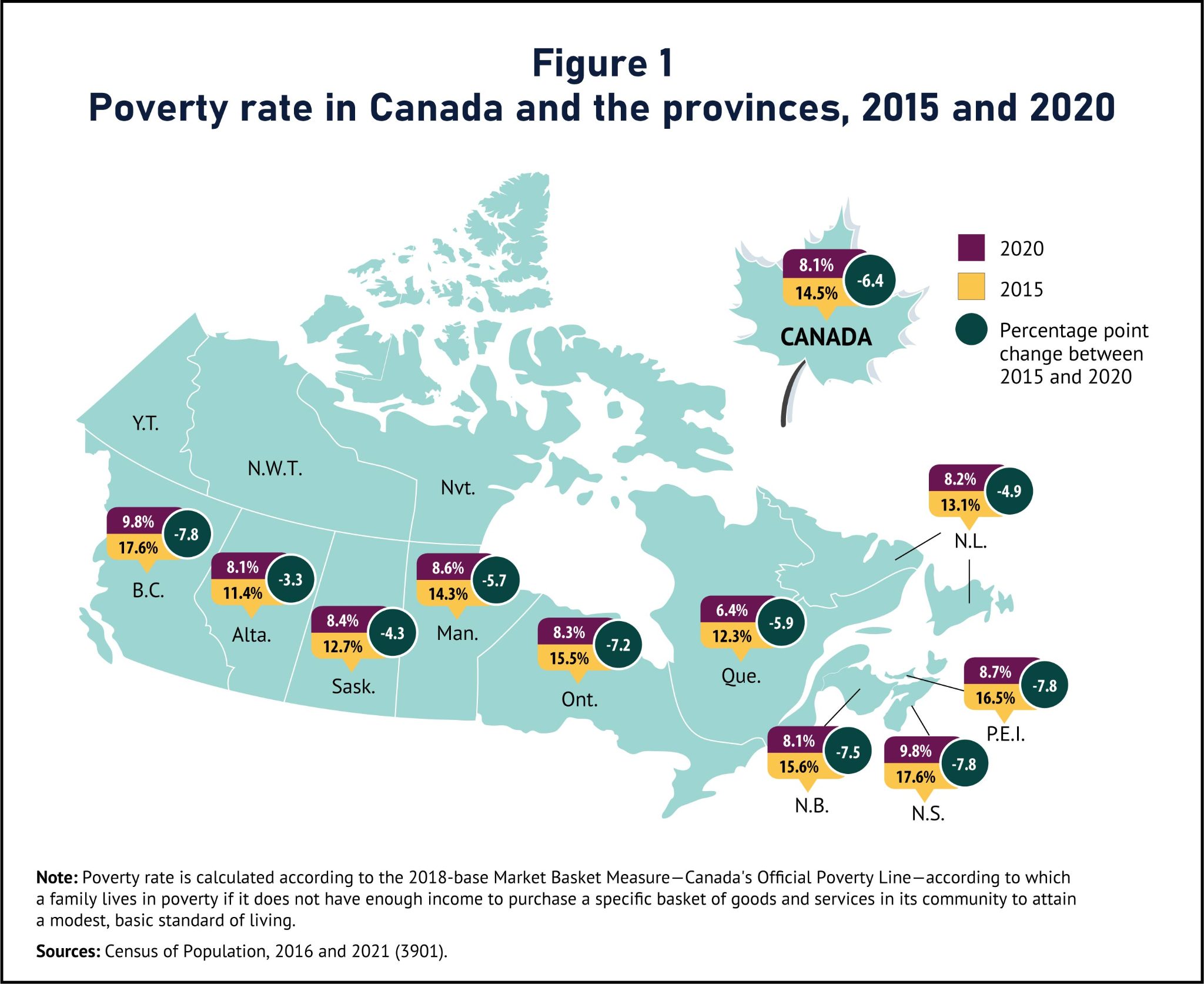
You can notice how most provinces hover around 8-10% for their 2020 poverty rate. The only exception is Quebec, at 6.2%.
The province with the highest rate was British Columbia, at 9.8%.
Poverty Rates Across Metropolitan Areas
The same source also lays out how the rates of poverty have fallen across Canada between 2015 and 2020.
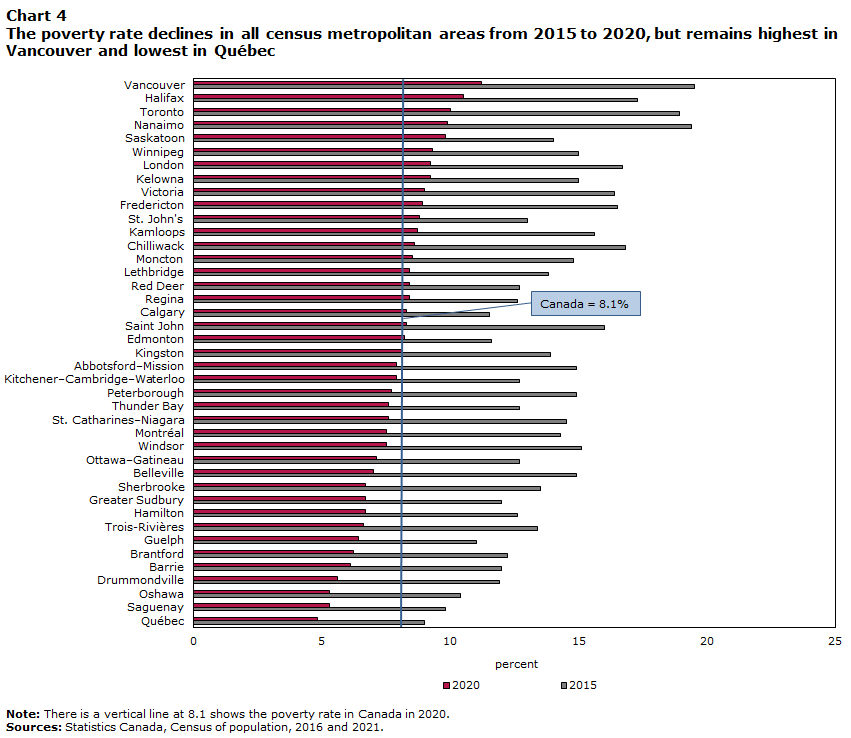
Notice that the poverty rate has fallen across all areas without exception.
Poverty Among Children
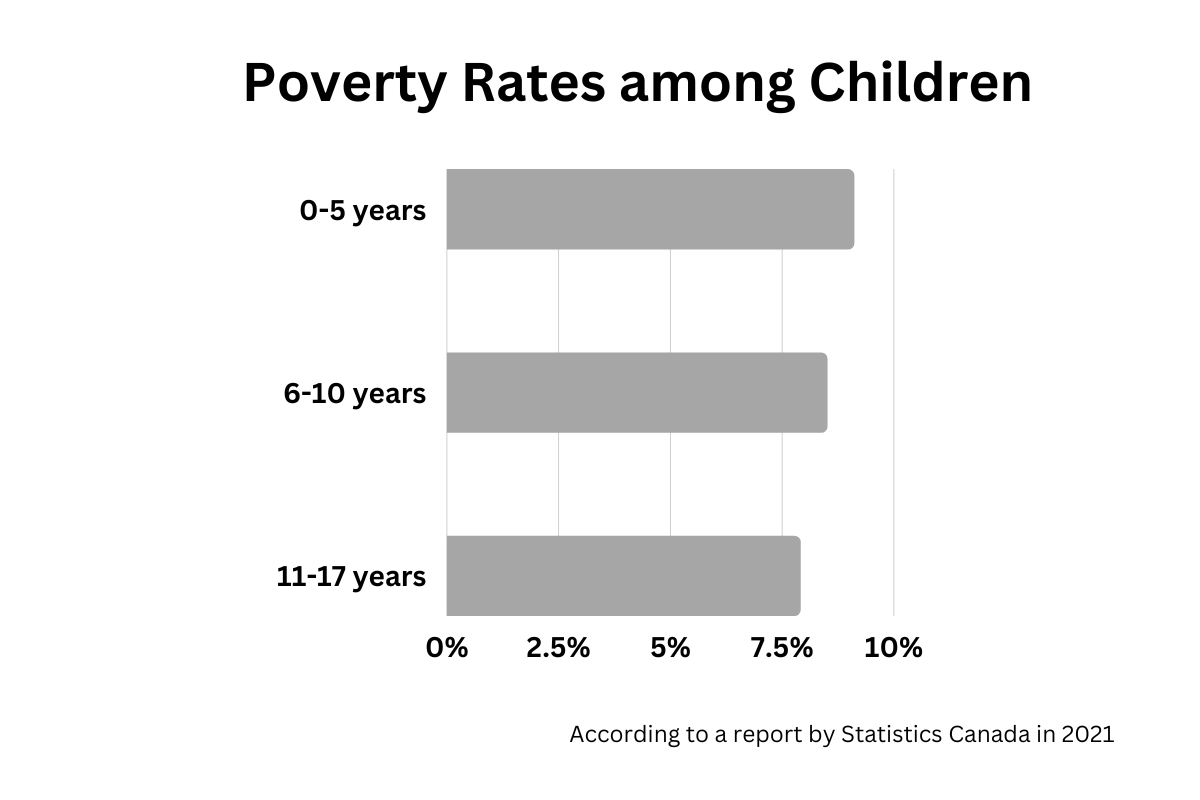
- Poverty among children has seen a particular decline. The poverty rates among certain age groups are as follows:
- 0 – 5 years:1%
- 6 – 10 years:5%
- 11 – 17 years:9%
These figures are less than half of what they were in 2015.
Poverty Among Racially Discriminated Groups
- Additionally, in 2020, among groups that were racially discriminated against and segregated from society, the following groups had higher poverty rates:
- South Asians:8%
- Chinese:3%
- Black Canadians:4%
There were variations to where people faced more discrimination. For example, the poverty rate among Black Canadians was 15.8% in Winnipeg and 9.7% in Montreal.
- Similarly, in the period of 2015 to 2020, a decrease in poverty rates was seen among the following groups:
- Arab Canadians in Regina: the poverty rate in 2015 was 57.1% and fell to 16.3% in 2020.
- Latin American Canadians in Winnipeg: the poverty rate varied only slightly, as it fell from 17.5% in 2015 to 15.9% in 2020.
- The poverty rate among immigrants declined significantly in 2020 (from 2015). It fell from 18.8% to 9.1%. However, the poverty situation is more prevalent among the non-native Canadian population.
What is the Relationship between Poverty and Crime?
The relationship between crime and poverty is fairly interesting and has been the subject of extensive research. An article by Pardons Canada dwells on the relationship between crime and poverty in Canada. The 2021 article findings stated that the poverty-crime connection was significant.
Pardons Canada is a national non-profit organization that removes criminal records to aid in a clear public record.
The article referred to a John Howard Society study, which came to its finding by interviewing and recruiting inmates scheduled for release– thus, inmates completing sentences. The study was based in 2014.
At the time of writing, this is the most relevant and up-to-date data we could find. But given that the relationship between crime and poverty is universal and is independent of time, the information below is still pertinent.
Income
The study first focused on the finance of the inmates, and the results on their flow of income were as follows:
- One-third (35.3%) of respondents relied on welfare benefits, particularly from Ontario Works (OW).
- 8% of respondents received benefits from the Ontario Disability Support Program (ODSP).
- 31% were employed, both part and full-time, before the incarceration.
- 20% had other means of income, including panhandling and illegal activities.
Housing
The John Howard study then looked into the housing of inmates before they had been taken into custody. In order to understand the socioeconomic position of the inmates before incarceration, they pursued a detailed analysis of the matter. The results were the following:
- For two years before their incarceration, 68.8% of respondents lived in at least one place.
- The surveyed lived in 5 places on average during those two years, indicating the extent of residential instability.
- 9% of respondents were homeless in the prior two years.
- 7% of respondents had a roomer, as they lived in a shared space.
- 4% of respondents stated they had access to regular or self-contained houses, such as an apartment or house.
- 8% of respondents said that they would not return to their residence prior to custody due to economic issues– inability to afford rent, family conflict, and wanting to avoid a risky environment.
Furthermore, the Pardons Canada article cited statistics from the Government of Canada, where a 2018 report found that 54% of the incarcerated inmates only had less than a 10th-grade education. It also found that 62% of incarcerated inmates were jobless during their arrest. The article used this evidence to prove that crime and poverty are interlinking concepts and are common variables in most inmates. It stated that poverty and criminal history perpetuate an endless cycle.
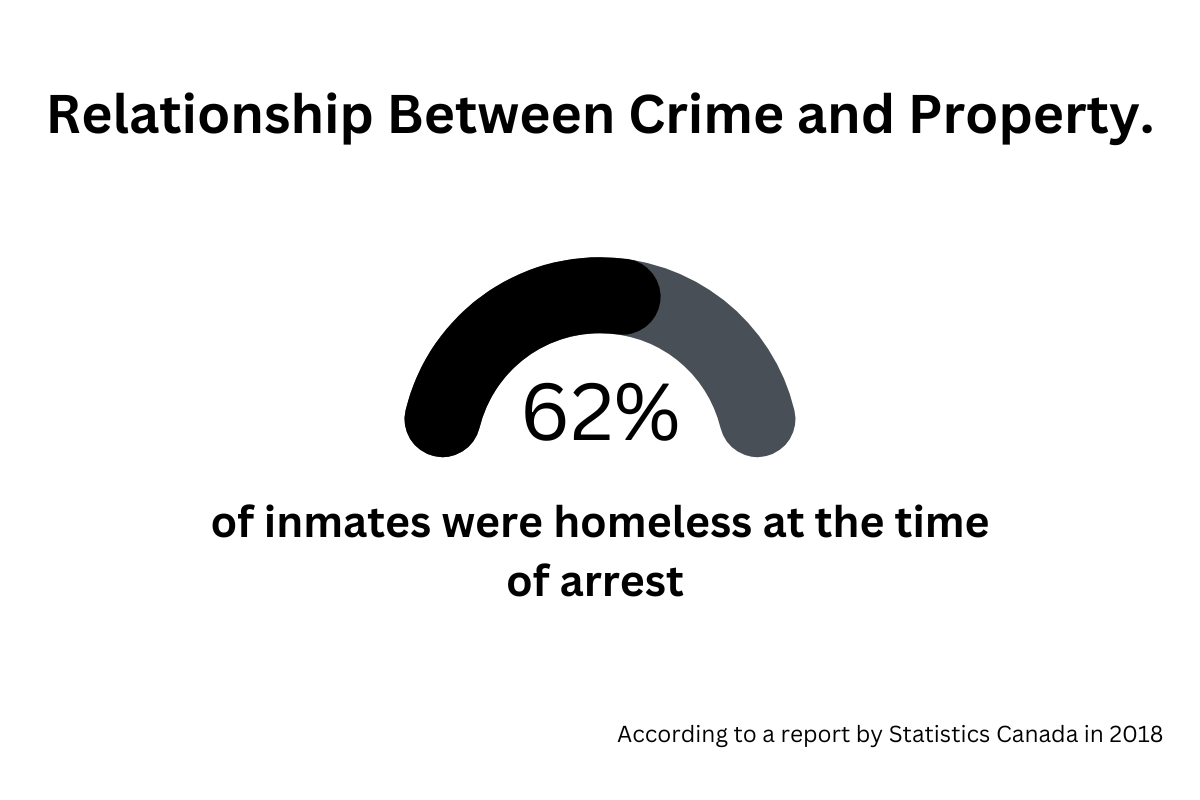
Supporting Studies
An experiment conducted in Dauphin, a town in Canada, provided an interesting perspective on the overlap between crime and poverty. David Calnitsky of the University of Western and Ontario and Pilar Gonalons-Pons of the University of Penn carried out the experiment in 2020. They used town-level crime data.
They offered universal basic income, a transfer payment made by the government. It serves as a reliable source of income for citizens. The results of the experiment were:
- Three hundred fifty fewer violent crimes per 100,000 people compared to other towns.
- The number of crimes dropped to 1400 fewer crimes per 100,000 people compared to the overall crime rate.
How Many Prison Inmates Come from Low-income Neighborhoods in Canada?
According to the Pardon Canada article mentioned above and its reference to the John Howard study, low-income Canadians dominated the criminal justice system compared to higher-income Canadians. It states that lower-income individuals in Canada are more likely to be detained, arrested, and convicted.
The article also mentioned a report by The Star in 2011, according to which only 10% of Canadians live under the poverty line. However, almost 100% of prison inmates are part of that 10%.
The Toronto Star is a daily newspaper and a multi-platform news organization. It is Canada’s largest daily newspaper.
The Star reports further statistics indicating the inmates were usually from lower-income households. It stated the following:
- 70% of offenders in prison had unstable job histories.
- 73% of homeless people had been arrested at least once.
- 49% of homeless people had been incarcerated once.
What Crimes are the Most Common in Low-Income Canadian Neighborhoods?
A CBC article explored recent data on crimes in low-income neighborhoods. The article focused on statistics from Vancouver, a Canadian City. The 2022 article stated violent crime in low-income areas rose after the pandemic.
CBC News is an outlet for national and international news. It is the largest news broadcaster in Canada.
Further down the timeline, a study by the Government of Canada provided a thorough analysis of crime trends in poor neighborhoods from 2004-2014. It states that while the overall crime rate fell, the rate of victims with lower incomes was much higher.
Comparing This With the Most Common Crimes in High-Income Neighborhoods
According to a Statistics Canada report about 2019, released in 2021, revealed that richer households, with annual incomes over $120,000, were more than twice as likely to be violently victimized (assault and robbery.)
Another extensive study in 2014 describes the relationship between household incomes and victims of crime in Canada. Public Safety Canada conducted it and found high crime rates, such as physical assault, sexual assault, and robbery. The aforementioned crimes were all 1.5 times greater in low-income households than in high-income households. We can presume low-income households are a part of low-income neighborhoods.
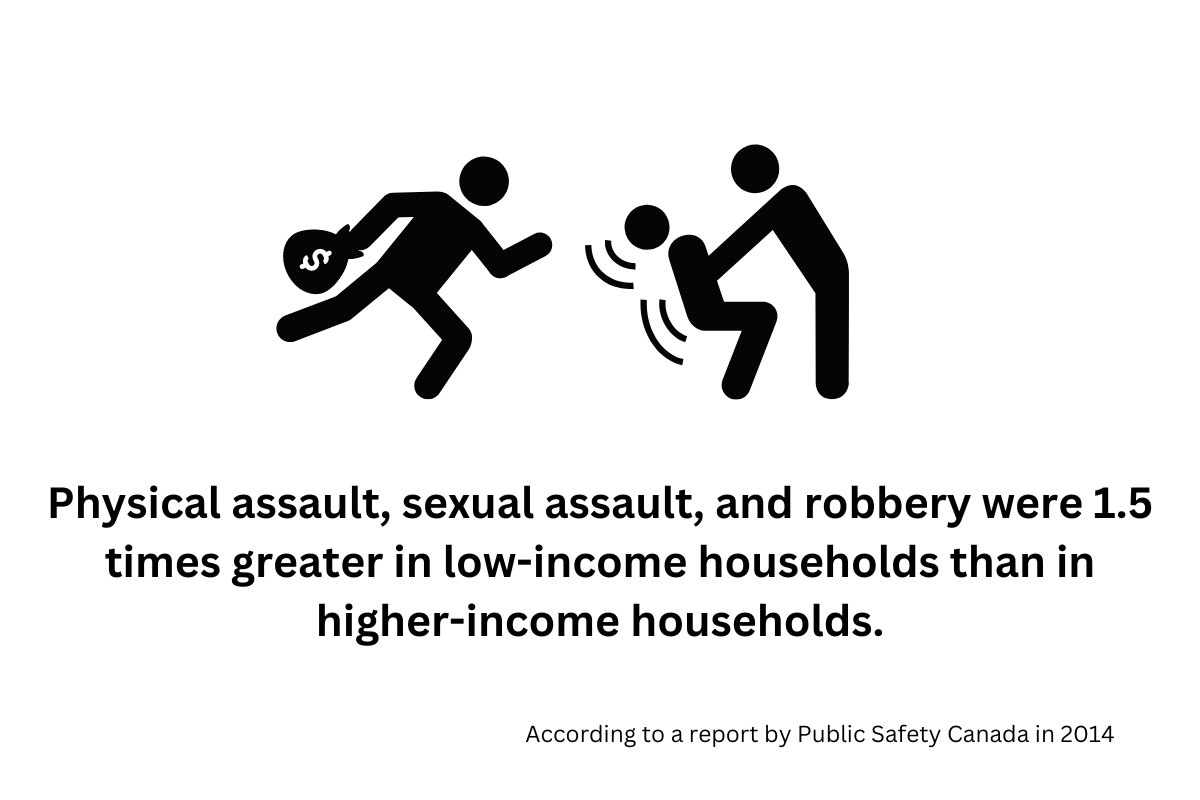
On the other hand, motor vehicle theft, theft of household property, and vandalism rates were much lower in lower-income households than in higher-income ones.
Public Safety Canada is a forum responsible for federal departments, national security, and ensuring safety in Canada.
Furthermore, the Government of Canada cited a 1999 General Social Survey (GSS). The survey determined that crimes such as breaking and entering, auto theft, and vandalism are greater in higher-income households than in lower-income ones. Thus property-related crimes are more common in higher-income neighborhoods.
What is the Distribution of Crime Rate in Canada?
A Statistics Canada report on police-reported crimes in 2021 presents important figures with respect to crime trends. The findings of the report were as follows:
- A 5% increase in the volume of violent crime reported by police took place in 2021.
- Rates of level 1 sexual assaults increased by 18%. Note that this category of crime is more commonplace in lower-income Canadian neighborhoods.
- Non-violent crime rates experienced a 3% decline in 2021.
- Canada had a 10% drop in breaking and entering cases. Note that property crimes are more common in higher-income neighborhoods.
- A 4% decline in cases of theft under $5000.
- Four in 10 homicides were related to fire-arms in 2021. Violent crimes wmare generally more likely in lower-income neighborhoods.
- Out of those homicides, 46% were considered to be gang-related.
- Hate crimes rose by 27% in 2021.
- Canada also experienced a 13% increase in opioid-related offenses.
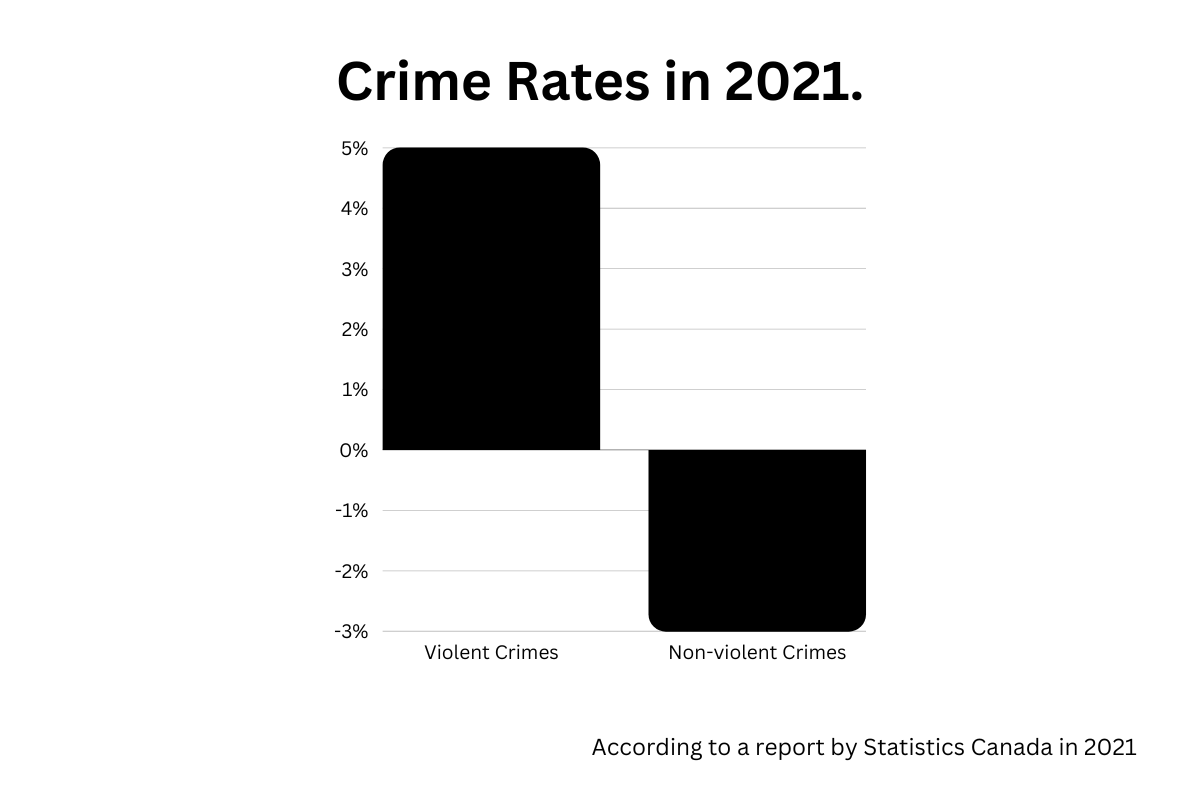
Conclusion
The cause of crime invariably conjoins with poverty and inequality. It stems from discrimination and a lack of facilities to halt the course of poverty. Policy-makers should take note of these motivations to take necessary steps against the phenomena. Alongside this, it stresses the need for countries to focus on their lower-income population to deter crime.
Based on research, crime and poverty seem to indicate a complementary pattern. Throughout the years, the overlap between incarcerated individuals and people in lower-income households or financial instability has been staggering. It shows that there are many macro-level steps Canada needs to take. The process could be through facilities and programs to aid individuals undergoing financial struggles.

